Newspapers
examiner.com

NPR on the Importance of Organization
 Today on Dan Rodricks’ show on WYPR’s 88.1 (NPR in Maryland) he featured two guests during his Midday show – Dave Bruno and Amy Rehkemper. Dan kicked off the show with Dave Bruno, a self proclaimed minimalist who has less than 95 items in his possession. Granted he confessed that he counts all his underwear as 1 item, but among his clothes, pens, gadgets, etc. – Dave has 95 items he can call his own. Dave explains in the interview with Dan that it isn’t about the magic number 95 – it’s about getting rid of things in his life that create clutter. He also shares that getting rid of items was harder than he expected – some charities were particular about the items he donated. So his endeavor was easier said than done but in the end – he prevailed. And he’s happier for it! And, as we can all imagine, he saves money. He doesn’t buy something new without thinking hard about it. Each new item is a tough decision because something has got to go – the decision of what he’ll get rid of so this new item doesn’t create more clutter. A lesson we could all learn!
Today on Dan Rodricks’ show on WYPR’s 88.1 (NPR in Maryland) he featured two guests during his Midday show – Dave Bruno and Amy Rehkemper. Dan kicked off the show with Dave Bruno, a self proclaimed minimalist who has less than 95 items in his possession. Granted he confessed that he counts all his underwear as 1 item, but among his clothes, pens, gadgets, etc. – Dave has 95 items he can call his own. Dave explains in the interview with Dan that it isn’t about the magic number 95 – it’s about getting rid of things in his life that create clutter. He also shares that getting rid of items was harder than he expected – some charities were particular about the items he donated. So his endeavor was easier said than done but in the end – he prevailed. And he’s happier for it! And, as we can all imagine, he saves money. He doesn’t buy something new without thinking hard about it. Each new item is a tough decision because something has got to go – the decision of what he’ll get rid of so this new item doesn’t create more clutter. A lesson we could all learn!
The second half, Dan Rodricks spoke with Amy Rehkemper, a professional organizer in Towson, Maryland. Amy gave listeners insight into the importance of clearing out the clutter and what it is like to work with a professional organizer. She talked broadly about the different types of clients she’s worked with – including chronic hoarders, ADHD, married couples, or people who work from home. One thing that she stressed was that regardless of the client’s needs they have to want to be organized. You can’t call on behalf of your sister and hire an organizer – your sister has to want to be organized and want to work with the organizer. As an organizer, if the client isn’t ready, then you are wasting the organizer’s time, the client’s time and the client’s money. Amy also stressed the importance of the age old rule – everything has a place. If you can’t find a home for something in your home then it will inevitably become clutter and it needs to go!
Dan Rodricks did a great job speaking with both Dave Bruno and Amy Rehkemper and taking questions and comments from callers. The hour long show drove home the importance of how clearing your clutter can make room for better things in your life. Sometimes this involves tough decisions but in the end these decisions give you the time, space, and peace that you’ve been searching for.
Baltimore Business Journal

Cleaning Up Clutter
by Joanna Sullivan
A pile here. A few more piles there. Soon there were piles everywhere.
Jim Blanchard dreaded even venturing into his cluttered office.
“I felt like coming into work everyday there was a 100-pound weight on my shoulders,” said Blanchard, who heads business development for Baltimore’s Vangel Paper Inc. “My desk was a mess. I felt like I was running around in circles. It got to the point where it was unbearable.”
Blanchard’s mess is not unusual. Walk around any workplace and you will find a cubicle where last week’s dirty coffee cup competes for space with last year’s financials. Nearby, there is a pristine cube where paper clips are organized by size and color. In most cases, messy or not, the desk typically doesn’t betray whether someone is a good or bad employee.
In fact, organizing experts — and there is a growing number of them out there — say clutter is only a problem if it starts affecting someone’s job performance or life.
For some people, those piles are a filing system. Their seemingly disorganized owner can find the document he needs in a flash. For others, those same piles — and the mess in the desk drawers not visible — become a hindrance to their productivity and sometimes even their sanity.
“You have to be able to find what you want when you need it,” said Amy Rehkemper, president of Simplify Organizing Services in Baltimore. “Being organized is not synonymous with clean or tidy. It means you can be comfortable in your surroundings.”
That comfort level, or lack thereof, is driving more individuals and businesses to seek professional help in getting organized. The Maryland Association of Professional Organizers, or MAPO as it’s called, is booming. In 2003, it had only 16 members. It now boasts 45, a majority of whom are women who wanted a business that provided flexibility. Of course, it also provides an outlet for their gift of organization.
Beth Savitz, MAPO’s outgoing president, said many of her clients have obsessive compulsive disorders or are hoarders who need someone to push them to get rid of clutter. They are often referred to her by psychiatrists. Others just reach a point where they decide they need to be a bit more orderly when it comes to their homes or offices. One woman called her after a bicycle fell onto the roof of her car in her overstuffed garage.
Tom Myers, an Owings Mills bank executive, said a co-worker pointed out that his work was being affected by his messy, disorganized office. That led him to Leslie Shreve, a professional organizer who has owned Just Imagine Organizing for three years. His company, Farmers and Merchants Bank, agreed to pick up the tab. Shreve charges $100 an hour for her services.
Myers said he was famous for carrying around index cards in his shirt pockets with a to-do list on them. Eventually, they would get too full or crumpled and he would start over again.
Shreve came in and got rid of the pocket to-do list and weaned Myers off his Franklin planner. He’s now on a Palm Pilot. The cleanup of his desk included the physical piles, the e-mails and computer files. He now uses computer programs for his to-do lists for both his business and personal life.
Among the personal list items on a recent January day? “Pay my wireless phone bill. Pack my cleaning. Pay soccer referees $10 each.” The work list included his various projects or bank clients.
The self-satisfaction is obvious when talking to Myers about his new ways. “After [Shreve] left, I was pounding my chest saying look at me how neat and tidy I am,” he said. “Every once in a while, I fall off the wagon. I realize I’ve slipped and I spend an afternoon cleaning up.”
But not everyone has a colleague to point out their messy ways. Home offices, often tucked away in a spare bedroom or den, offer the perfect hideaway for the hoarder.
Janet Lord, an international lawyer who works from her Roland Park home, said she hired a professional organizer to sort through the backlog of boxes from several past offices because the mess was making her anxious. She expanded into other parts of the house as the papers and boxes stacked up.
Savitz, who owns Instantly Organized, forced her to go through those boxes and get rid of things. Her most prized possession now is a label maker.
“I’m no longer using my dining room table,” Lord said. “I’m actually using my home office and enjoying it.”
But what if you can’t shell out the $45 to $100-plus an hour to hire a pro to organize your life and things?
There is a growing do-it-yourself industry catering to home and office organization. And self-help books, computer programs and even the old-fashioned daily planners strive to turn anyone into a model of efficiency.
Still, some experts question whether there is too much emphasis on organization these days anyway. They see color-coding files and creating an elaborate e-mail filing system as another way to procrastinate getting the real work done.
Rehkemper, who organizes for a living, knows some people probably can’t change their ways. She grew up with parents who were the consummate packrats. It was a catalyst to her own career. She likes giving people a spark of hope that they can improve their environment, even just a little bit.
But she warns anyone from carrying the concept too far.
“From time to time, I like to throw my coat on the couch,” she said. “If you’re trying to constantly clean up after yourself, then you can’t enjoy the moment.”
The Baltimore Sun

A Call to Order – The New Year is a Great Time to Get Organized
By Carl Schoettler
CLUTTER, DISORDER, DISARRAY
Complete Article
A desk inundated by papers last examined in 1998. Books stacked beyond recall by the Dewey Decimal System. John Coltrane CDs “filed” next to Vivaldi. Forgotten substances stored at the back of the refrigerator. Closets stuffed with stuff unworn since the Nehru-collar era. Pantry and garage indescribable to ordinary mortals.
Perhaps you, as I do, face this new year threatened by the dreaded syndrome Chronic Disorganization. I sought professional help. January is, after all, Get Organized Month.
For those like us, there are endless resources to call on, from magazines to books to helpful Web sites. But to really understand what getting organized takes, I decided to start at the top. I called Barry Izsak, president of the National Association of Professional Organizers, in Austin, Texas.
Izsak’s counsel, of course: Hire a professional organizer. There are 3,500 in 24 NAPO chapters, probably 150 or more in Maryland, Washington and Washington’s Virginia suburbs. But there are some things you can do without professional help.
“Break the task into small, manageable pieces,” Izsak says, with the firm, didactic tone of a stern schoolteacher. “You need to focus in on one small piece, whether it’s the medicine cabinet in the bathroom, or the bathroom itself, if it’s small, or the CDs in your office.”
Select an area to begin, then remove items from the area so you have room to work.
“You then need to sort the items,” Izsak says. “Make the easy decisions first. The obvious: Things that are broken. Things that are incredibly old. Things that are no longer useful. Remove … sort …get rid of the things you don’t need.”
Next, he says, “Select a `home.’ ” In organizing, that means the natural place to put stuff.
“This could either be the place that you remove the items from, or a new home you create in a different area. Containerize the items if you need to, if it would help them stay together better. Then replace the item. That’s the process in a nutshell.”
Oftentimes, Izsak says, “Clients ask me where should I put this. The answer is, where you would you go look for it. … You want to store things near where you’re going to use them.”
He says you should ask yourself lots of questions as you go through the process of whether you should keep something or not: When was the last time you used it? Is it still useful and relevant? In good working condition? Is there a logical place and enough space to keep it?
“And my favorite question,” he says: “What’s the worst thing that’s going to happen if you get rid of it? And if you can live with your answer, get rid of it.”
Like many professional organizers, Izsak sometimes sounds like a psychotherapist.
“Contrary to what people believe,” he says, “being organized is not an inherited trait. It’s a learned behavior. … Unfortunately, most people were never taught. They don’t know how to do it.”
The ultimate goal, he says, ” is not the organization.
The ultimate goal is to be more productive. And to alleviate stress. And to save time and … money.”
ORGANIZED, NOT “NEAT”
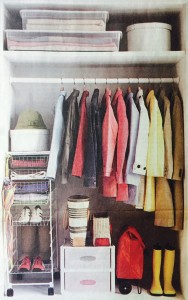
A variety of containers can help you set up a closet where everything’s neatly in place. (All photos by Anne-Michelle Gallero, from “Real Simple: The Organized Home Book”)
Amy Rehkemper, the founder and owner of Simplify Organizing Services in Towson, grew up in a family where organization not only wasn’t taught, it was ignored.
“I had a beautiful childhood,” she says. “But it was cluttered.”
She rebelled by getting organized. She’s been a professional since June 1999. Some organizers work from a designer-architectural standpoint — the creation of pristine rooms like those in Martha Stewart’s Living or Real Simple magazine. Rehkemper is more permissive.
“A lot of people confuse being neat and being organized. [They’re] not the same thing,” she says.”Organization means something different to every single person,” she says. “So when I go into a client’s home I don’t touch anything, I don’t do any hands-on organizing until I have spoken with you and really understood what’s your style, what are your needs, what are your habits.”
Then she begins to sound as firm as Izsak, but like a kindly, cheerful, good organizer cop. “Getting organized is about finding what you need when you need it,” she says. “It’s not necessarily that the place looks pretty.”
Rehkemper founded the Maryland Association of Professional Organizers in 2001 and was its first president. Membership fluctuates between 35 and 40. (MAPO is not affiliated with NAPO.)
IN THE COMMUNITY
She’s led MAPO on pro bono expeditions to organize the tool room for Habitat for Humanity and storage and food stocks for the House of Ruth. And they’ve just rearranged some jumbled rooms at Baltimore’s Collington Elementary School.
And Rehkemper has finally organized parts of her childhood home. “Slowly but surely,” she says.
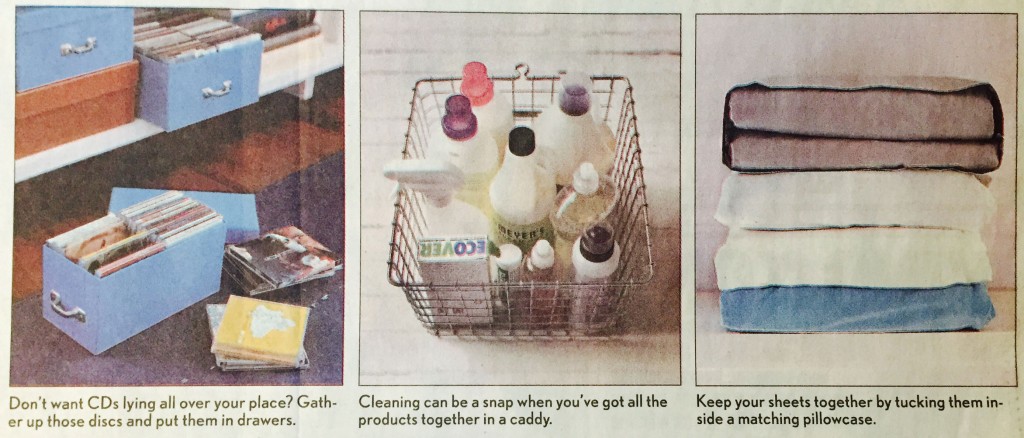 Scott Roewer of Solutions-by-Scott practices organizing in Washington.
Scott Roewer of Solutions-by-Scott practices organizing in Washington.
“We have a lot of people who move into D.C. who’ve lived in large Midwest homes and have to figure out how to downsize,” he says. “They bring all their clutter that they’ve had forever with them.”
Disorganization is like snow, he says. It piles up until you do something about it.
“We work with people side-by-side,” he says. “We help them make the decisions they need to go through the piles of paper, the attic, the garage, the boxes that were sometimes not unpacked from the last move. We help them adapt to changing their habits so they don’t re-bury themselves.”
He’s organized everything from nurseries to law offices, but he loves to work on closets. So far he’s never found any of the skeletons said to reside in many Washington closets.
“No,” he says. “Thank goodness.”
He wouldn’t tell anyway. A professional organizer in Washington must have the discretion of a CIA agent.
“We have standards of conduct we follow,” he says, a bit stiffly. “And everything is confidential.”
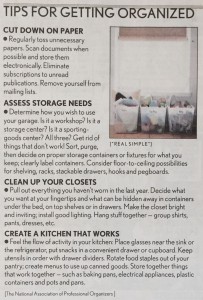
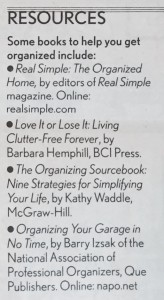
Towson Times

Clutter Buster Brings Order to Basement Chaos
by Bob Allen
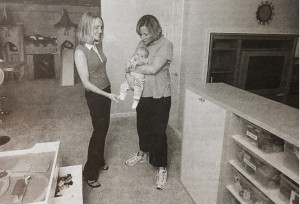
Amy Rehkemper, owner of Simplify Organizing Services of Towson (left) consults with Timonium homeowner and mother Jenny Howard, who is holding her six-week-old son, Jamie. Howard’s basement makeover will be featured on HGTV’s “Mission: Organization” premiering 9:30pm on Sept. 6th on HGTV.
Timonium resident Jenny Howard may not be famous, but her basement soon will be. Not too many people will recognize the new, re-imagined and reinvented living space, which just a few months ago, according to Howard, looked “like a pigsty.”
The basement playroom, once a helter-skelter, chockablock repository for toys and just about anything else that wouldn’t fit elsewhere in the house, has had a dramatic facelift and a comprehensive nip- and-tuck, a real Hollywood-style makeover. Well, at least a Home & Garden Television network-style makeover.
The once chaotic basement’s dramatic transformation was performed courtesy of Amy Rehkemper, founder and owner of Simplify Organizing Services, a Towson-based space reorganizing and room rescue consultancy.
Rehkemper did the makeover for an HGTV home-improvement show called “Mission: Organization.” The program on Howard’s basement that was filmed in February will air for the first of several times at 9:30 p.m. Sept. 6. HGTV is carried on channel 46 on Comcast Cable in Baltimore County.
A production crew from “Mission: Organization” made five lengthy visits to Howard’s house during crucial stages in the makeover, which took about a month to complete.
“We could barely walk through the room before,” said Howard, a former pediatric nurse at Kennedy Krieger Institute who is now a stay-at-home mom with three small boys. “It was basically a dumping ground where we put everything that we didn’t have any place else to put.
“But when Amy was finished, everything was organized,” added Howard, who has been a client of Rehkemper’s in the past. “She has a real eye for this. She can see a whole room like this one was before, and she can see how to improve it. Whereas I’m just … dumbfounded.”
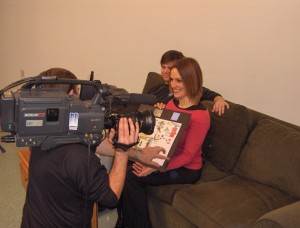
Organizer Amy Rehkemper and homeowner J.B. Howard pose for the HGTV camera.
Rehkemper, who did a master bedroom makeover for a 2003 episode of “Mission: Organization,” said it’s all in a day’s work for her. Where a less organized person might experience bewilderment or even utter demoralization in the face of such wall-to-wall, ceiling-to-floor chaos, Rehkemper merely smiles, rolls up her sleeves and plunges in.
She insists that the dishevelment in Howard’s basement was child’s play compared to some room makeovers she’s taken on.
“I’ve actually had clients who moved out of their messy homes to new homes, and they filled the new ones up too,” she said cheerfully. “That’s when they call me.”
Nearly every last one of them has used the world ‘overwhelmed,'” added Rehkemper, who is a founder, past president and current board member of a trade organization called Maryland Association of Professional Organizers. “People get to the point where they’re stuck in clutter, and they can’t get out of it.”
Even though it was Rehkemper who approached Howard about being a potential guinea pig when the TV show asked her to do an episode for the 2005 season, Howard agrees that “overwhelmed” was an apt description of her plight. With Jack, her 6-year-old, Jeffrey, 1-and-a-half and 6-week-old Jamie on her hands, she had neither the time, nor energy to confront the basement clutter.
“Amy redesigned it so everything has a place, whereas before my husband, J.B., and I didn’t even know where to start,” she said. “It would have taken us years to do what she did in a month, and it’s so much more peaceful being in an organized environment.”
Howard said it’s a testimonial to Rehkemper’s organizational savvy that even Howard’s 6-year-old son has learned a thing or two from her. “He’ll say things like ‘Amy would not want us to do that,'” she said. “And I’ve even been able to get him to put away toys … at least a little bit more often than he used to.”
The Baltimore Sun

Little Picassos- Your young artist keeps churning out one masterpiece after another. Here’s how to display the best of it.
by Kate Shatzkin
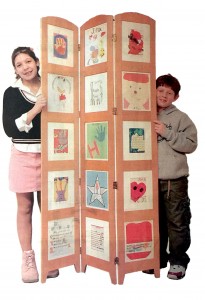 Making art is one of a child’s earliest creative acts. It’s evidence of his development, a springboard for discussion, a key to his soul. And, let’s face it, a storage dilemma for his parents.
Making art is one of a child’s earliest creative acts. It’s evidence of his development, a springboard for discussion, a key to his soul. And, let’s face it, a storage dilemma for his parents.
From a toddler’s first doodles to a teenager’s elaborate painting, kids generate thousands of pieces of art at home and school. The refrigerator holds only so much. Yet throwing away a young one’s creation can feel just wrong.
We turned to professional organizers and parents for tips on putting kids’ work in its place – some of them just as creative as the art itself.
Sort it. Keep drawings and paintings for a while, then get your child involved in choosing favorites to keep – and others to toss.
“It is an important life lesson for your child to learn that not every single thing they draw merits being kept,” says Baltimore professional organizer Amy Rehkemper. “The most important part of their artwork was their experience creating it, not the experience of watching it collect dust on the kitchen table.”
Recycle it. Wrap gifts in pieces the kids are willing to part with. Or use several old works of art to create a new one.
Give it, periodically, to a relative or close friend. Far-away grandparents will especially appreciate receiving this tangible connection to their grandchildren.

Towson Times

A Place For Everything and Everything in Its Place
by Loni Ingraham
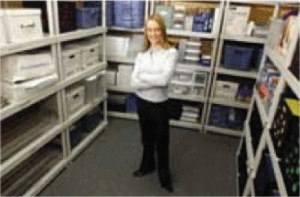
Amy Rehkemper, owner of A Place For Everything Organizing, in her office on East Joppa Road.
Amy Rehkemper, proprietor, chief cook and bottle washer of A Place for Everything Organizing, says the name of her business says it all.
“It’s a great tip for people,” says Rehkemper, whose office is at 1705 East Joppa Road. “Create a place for things, and you won’t lose them. Organization helps a lawyer or a mother of five. Everyone can benefit from organization.”
That includes Rehkemper herself, a 29-year-old reformed “messy.” Yes, she was a messy little kid, she says. She was interested in everything, a scattered approach. Then she went from B’s and C’s to straight A’s. “What happened?” people asked her. “I have organized my surroundings,” she told them. “I can think clearly now.”
She decided to make a career of organizing four years ago because it worked for her. When she graduated from Towson University with a degree in elementary education, she was very employable, she says. But her experiences in the classroom, volunteering and tutoring, made her realize a school system might not be the perfect place for her.
“I loved the order involved, but I found it to be very bureaucratic,” she says. “I’m a people pleaser. I’m not happy unless everybody else is happy. There were too many people that had to be pleased: the kids, the teachers, the parents, the school board.”
It was a conversation with her husband, David, that led her to opt for a career in organization instead. When he asked her what she would like to do if she could do anything, she told him she would love to go into people’s houses and show them how to get rid of all the junk that is preventing them from reaching their goals. Shortly thereafter, she started her business in a room of her Loch Raven Village town house.
“People can get stuck in the past with all this junk and confusion that is truly holding them back from what they want,” she says. “I help them de-clutter and create simple systems to bring order in their lives.”
After four years, she has helped people organize numerous attics, bedrooms, kitchens, closets, garages and offices. She charges about $60 an hour, “less than a decorator and more than a cleaning service,” she notes. She still uses her teaching and coaching skills, but she only has to please one client or one family at a time. No job overwhelms her. When she walks into chaos, she gets excited.
“I can help them even more,” she says. “I’m the coach that helps them stay focused and go through the clutter until everything is purged or in order.” Rehkemper says she is committed to maintaining confidentiality and to being nonjudgmental. “I take people’s lives seriously,” she says. “For them to go through their belongings is an emotional experience.”
Story also covered March 11, 2004

Story also covered March 31, 2004

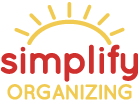
 Newspaper
Newspaper Magazine
Magazine